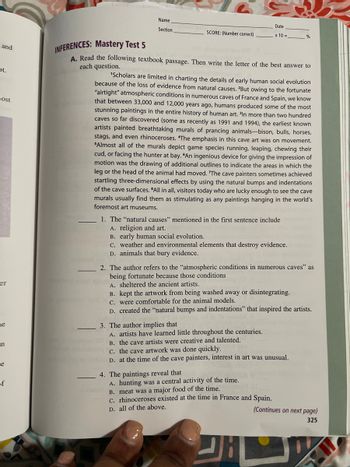Question

Transcribed Image Text:324
PART ONE
Ten Steps to Advancing College Reading Skills
5. When he then says that life is "a tale/Told by an idiot, full of sound and
fury,/Signifying nothing." Macbeth implies that
A. life is meaningless.
B. people often pretend to care about things when they really do not.
c. people of low intelligence are often angry.
B. (6-10.) Read the graph below. Then check (✔) the five statements that are most
logically based on the graph.
World's Water Supply
Polar ice and glaciers
2%
Liquid salt water in
oceans and seas
97%
Circulating fresh wate
and water vapor
1%
1. By far, the majority of the world's water is salt water.
2. The pie graph represents 50 percent of the world's water supply.
3. The pie graph represents 100 percent of the world's water supply.
4. There is more water in polar ice and glaciers than there is fresh water
and water vapor in the world.
5. About 97 percent of the world is covered in water.
6. About 1 percent of the world is covered in water.
7. The water in the Pacific Ocean is part of the 97-percent section of the
pie graph.
8. The water that we shower in is represented in the 97-percent section
of the pie graph.
9. The humidity in the air is represented by the 2-percent section of the
pie graph.
10. Life processes of the plants and animals on land use the 1 percent of
fresh water and water vapor in the world.
INFEREN
A.

Transcribed Image Text:Name
Date
Section
SCORE: (Number correct)
x 10=
%
and
Ot.
most
er
ne
.n
e
of
INFERENCES: Mastery Test 5
A. Read the following textbook passage. Then write the letter of the best answer to
each question.
'Scholars are limited in charting the details of early human social evolution
because of the loss of evidence from natural causes. 2But owing to the fortunate
"airtight" atmospheric conditions in numerous caves of France and Spain, we know
that between 33,000 and 12,000 years ago, humans produced some of the most
stunning paintings in the entire history of human art. In more than two hundred
caves so far discovered (some as recently as 1991 and 1994), the earliest known
artists painted breathtaking murals of prancing animals-bison, bulls, horses,
stags, and even rhinoceroses. "The emphasis in this cave art was on movement.
"Almost all of the murals depict game species running, leaping, chewing their
cud, or facing the hunter at bay. "An ingenious device for giving the impression of
motion was the drawing of additional outlines to indicate the areas in which the
leg or the head of the animal had moved. 'The cave painters sometimes achieved
startling three-dimensional effects by using the natural bumps and indentations
of the cave surfaces. All in all, visitors today who are lucky enough to see the cave
murals usually find them as stimulating as any paintings hanging in the world's
foremost art museums.
1. The "natural causes" mentioned in the first sentence include
A. religion and art.
B. early human social evolution.
C. weather and environmental elements that destroy evidence.
D. animals that bury evidence.
2. The author refers to the "atmospheric conditions in numerous caves" as
being fortunate because those conditions
A. sheltered the ancient artists.
B. kept the artwork from being washed away or disintegrating.
c. were comfortable for the animal models.
D. created the "natural bumps and indentations" that inspired the artists.
3. The author implies that
A. artists have learned little throughout the centuries.
B. the cave artists were creative and talented.
c. the cave artwork was done quickly.
D. at the time of the cave painters, interest in art was unusual.
4. The paintings reveal that
A. hunting was a central activity of the time.
B. meat was a major food of the time.
C. rhinoceroses existed at the time in France and Spain.
D. all of the above.
(Continues on next page)
325
Expert Solution
This question has been solved!
Explore an expertly crafted, step-by-step solution for a thorough understanding of key concepts.
This is a popular solution
Trending nowThis is a popular solution!
Step by stepSolved in 3 steps
